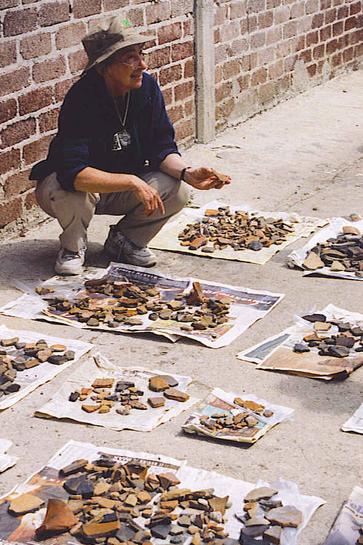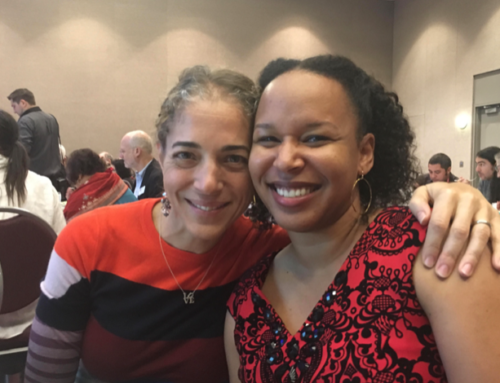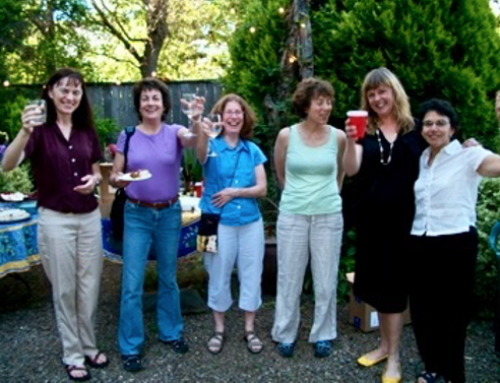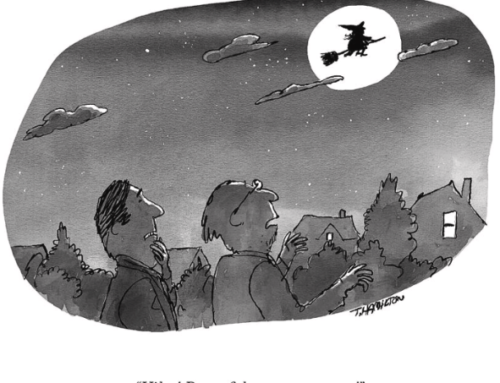Elizabeth Brumfiel was among the first group of scholars in archaeology to explore gender roles and ideologies in the past. Her article “Weaving and Cooking in Aztec Mexico” in the pathbreaking 1991 volume edited by Joan Gero and Margaret Conkey, Engendering Archaeology, examined changes in women’s roles under subordination by the Aztec Empire. Although historic documents stereotyped women as weavers, Brumfiel found that under Aztec rule, the type of work that women did varied according to the possibilities of their geographic contexts—for example, where there was easy access to markets, women focused their efforts on market-oriented food production and purchased cloth to meet tribute demands. Yet, where distance prevented easy access to markets, women wove tribute cloth themselves. Brumfiel highlighted the variability in women’s roles and demonstrated that gender roles must be contextually situated.

Elizabeth Brumfiel
Brumfiel’s work demonstrated that archaeology could provide a democratic perspective of the past, whereas documents and elite monuments presented a normative and static view of gender systems by reflecting the ideologies of the dominant class. In her 1996 article, “Figurines and the Aztec State,” Brumfiel found that dominant gender ideologies promoted by states did not necessarily extend into popular consciousness. While official Aztec state-produced monumental art reflected an ideology of male dominance through depictions of mutilated women and the glorification of male warriors, popular art in the form of figurines increasingly emphasized women and their reproductive roles. Brumfiel argued that the very visible state-promoted ideology of warfare centered on males was not embraced by commoners. In order to understand past societies and gender systems, she thus also emphasized the importance of studying commoner contexts and households, not only the pyramids and palaces of the elites.
Perhaps most importantly, Brumfiel unapologetically emphasized the political implications for the study of gender in archaeology and highlighted its relevance to the present. At a time when many archaeologists ignored the implicit biases in seemingly objective research and expressed distain for work that acknowledged subjectivity, she instead advocated for archaeology to take on a political role. In her 2006 article, “Cloth, Gender Continuity, and Change,” Brumfiel argued that archaeology enables us to critique modern gender ideologies and essentialist assumptions about gender. She suggested that through archaeology and historical comparison we can see how practices and beliefs about gender have changed over time and are contingent upon historical and regional contexts.
When I first started graduate school, I had zero background in anthropology as I had majored in evolutionary biology. Although I had taken many courses on archaeology in undergrad, participated in archaeological excavations, and Jim Deetz’s In Small Things Forgotten was my favorite book from college, I had never taken an actual course in anthropology nor would I have considered myself a feminist. I decided to go to graduate school in anthropological archaeology because I realized that all my interests ultimately distilled down to my fascination with understanding human beings. But after a while in graduate school, I found the emphasis on “systems” approaches in archaeology to be boring and people were surprisingly absent. Meanwhile, in my courses on human evolution, I was stunned by unquestioned androcentric assumptions. The idea that male hominids provisioned female hominids with food, while females sat around and took care of infants seemed utterly ridiculous from my understanding of biology, animal behavior, and evolution. I did not know much about anthropology, but I soon came to the conclusion that it was sexist.

Elizabeth Brumfiel and Kristin De Lucia
Everything changed when in my graduate theory course, we read an article by Elizabeth Brumfiel, “The Quality of Tribute Cloth: The Place of Evidence in Archaeological Argument” (1996). Using a feminist framework, she examined her own process of hypothesis formation, assumptions, and data interpretation. Her data contradicted her hypothesis that Aztec women resisted tribute demands by weaving poor quality cloth. Rather than concluding that women did not resist, she instead argued that women would have engaged in resistance if they had been able, and supported her argument with other lines of evidence. To see an archaeologist clearly lay out their assumptions, theoretical framework, and add nuance to data interpretation, rather than present their work as objective, straightforward, and self-explanatory, was a watershed moment for me and exposed so many of the frustrations I was experiencing with archaeology. My peers were shocked by her ad hoc modification of her theory, but I thought it was a clever critique of the research process. I next read Brumfiel’s “Distinguished Lecture: Breaking and Entering the Ecosystem—Gender, Class and Faction Steal the Show” (1992). In it, she wrote that “culturally based behavioral ‘systems’ are the composite outcomes of negotiation between positioned social agents pursuing their goals under both ecological and social constraints” (1992: 551). Brumfiel’s work put people back into archaeology and made archaeology interesting. I devoured her work, sought out the work of other feminist archaeologists, and finally became excited about archaeology again.
Soon thereafter I found out that Elizabeth Brumfiel was looking for graduate students to supervise fieldwork and I jumped at the opportunity. I ultimately left my program and followed Brumfiel to Northwestern University to complete my PhD, where I also had the opportunity to study and work with other brilliant feminist scholars including Cynthia Robin, Mary Weismantel, and Micaela di Leonardo. At Northwestern, I took a course on gender archaeology co-taught by Brumfiel and Robin. In that course, I read Robin’s article “Gender, Farming and Long-Term Change: Maya Historical and Archaeological Perspectives” (2006), which provided a model for the type of archaeology I wanted to do. The course also resulted in a conference panel at the AAAs and ultimately a special issue of the AP3A, Gender, Households, and Society: Unraveling the Threads of Past and Present (Robin and Brumfiel 2008). The course created a bond among our cohort and many years later, I co-edited a volume, Surplus: The Politics of Production and the Strategies of Everyday Life (2015) with one of my colleagues from that course, Christopher Morehart. Brumfiel and Robin did not just teach a class on feminist archaeology, but they also created opportunities and ties that endured well beyond the classroom.
Liz Brumfiel taught at Albion college for twenty-five years before she moved to Northwestern. Despite the fact that for most of her career she lacked the resources and support of a large research institution, she published extensively and was well known for her work. She told me that while her colleagues relaxed over summer breaks, she wrote articles and conducted fieldwork. Liz also took great pride in teaching undergraduates, especially at Albion, where she said that many students did not have much experience beyond their hometowns. She believed that teaching was a powerful force to change the world, one mind at a time. When she passed away, her students from up to thirty years prior posted comments on Albion’s website about the influence she had on their lives. One of her students wrote: “[Brumfiel] changed for the better the way I think and also how I look at the world and its occupants.” As I now teach at a liberal arts college, I regularly focus on the importance of archaeology to understanding the present in my teaching and I think about the lessons that I learned from Liz.
I can confidently say that without the support of a network of feminist mentors, I would not be in academia today. As a mentor, Liz often shared her experiences and advice about being an archaeologist, a mother, and a woman in archaeology. She always readily admitted her insecurities, which helped me to feel better about my own. Cynthia Robin worked tirelessly with me on my dissertation, even when her own plate was more than full. Cynthia always provided extensive feedback and was willing to have long phone conversations well after I graduated. Micaela di Leonardo fought to keep me funded when few resources existed for graduate students. I was struggling financially on a graduate student salary with one infant and another on the way, when I was told that I would no longer qualify for teaching assistantships (and consequently health insurance). There was no maternity leave for graduate students, childcare was completely unaffordable, and I could not “stop the clock” as faculty could. But with the help of my mother-in-law who babysat part-time and graduate school friends who generously offered babysitting services, I made progress on my dissertation and was nearly finished. When Micaela found out about my situation, she advocated vehemently on my behalf to the administration for additional funding so that I could complete my dissertation. Feminist anthropology, thus, is far more than just influential texts, but is also practice.
I am eternally grateful to my feminist mentors, but I realize that many others have not been as lucky. The resources available to graduate students with families in the United States are slim. This is not just an issue of gender equity but also race and class, as people with fewer resources are less able to subsist on graduate student salaries. Childcare is still not a priority for most graduate institutions; many professional organizations still do not regularly provide childcare at meetings; and during the Covid-19 crisis women have disproportionately shouldered the burden of childcare and education as schools have closed, likely impacting women’s careers for years to come. Further, the recent #MeTooAcademia movement has finally begun to expose the deeply entrenched gender disparities, sexual assault, and misogyny that have characterized anthropological and archaeological fieldwork for decades. Thus, there is still work to be done. We must rely less on the often-unacknowledged labor of mentorship, especially the emotional labor performed so disproportionately by women and people of color, and begin to institute structural changes in academia that acknowledge the realities of our contemporary lives.
References
Brumfiel, Elizabeth M. 1991. “Weaving and Cooking: Women’s Production in Aztec Mexico.” In Engendering Archaeology: Women and Prehistory, edited by Joan M. Gero and Margaret W. Conkey, 224-251. Oxford: Blackwell.
Brumfiel, Elizabeth M. 1992. “Distinguished Lecture in Archaeology: Breaking and Entering the Ecosystem-Gender, Class, and Faction Steal the Show.” American Anthropologist 94 (3):551-566.
Brumfiel, Elizabeth M. 1996. “Figurines and the Aztec State: Testing the Effectiveness of Ideological Domination.” In Gender and Archaeology, edited by Rita P. Wright, 144-166. Philadelphia: University of Pennsylvania Press.
Brumfiel, Elizabeth M. 1996. “The Quality of Tribute Cloth: The Place of Evidence in Archaeological Argument.” American Antiquity 61 (3):453-462.
Brumfiel, Elizabeth M. 2006. “Cloth, Gender, Continuity, and Change: Fabricating Unity in Anthropology.” American Anthropologist 108:862-877.
Deetz, James. 1996 [1977]. In Small Things Forgotten: An Archaeology of Early American Life, Expanded and Revised Edition. New York: Anchor.
Gero, Joan M., and Margaret Wright Conkey. 2002. Engendering Archaeology: Women and Prehistory. Oxford, UK; Cambridge, Mass., USA: B. Blackwell.
Morehart, Christopher T., and Kristin De Lucia, eds. 2015. Surplus: The Politics of Production and the Strategies of Everyday Life. Boulder: University of Colorado Press.
Robin, Cynthia. 2006. “Gender, Farming, and Long-Term Change: Maya Historical and Archaeological Perspectives.” Current Anthropology 47 (3):409-354.
Robin, Cynthia, and Elizabeth M. Brumfiel. 2008. Gender, Households, and Society: Unraveling the Threads of the Past and the Present. Malden, MA; [Arlington, Va.]: Blackwell; American Anthropological Association.
Cite as: De Lucia, Kristin. 2021. “Studying the Past to Understand the Present: Elizabeth Brumfiel Making Archaeology Interesting with Gender, Class, and Faction.” In “Genealogies of the Feminist Present: Lineages and Connections in Feminist Anthropology,” edited by Lynn Bolles and Mary H. Moran, American Ethnologist website, 24 May 2021, https://americanethnologist.org/features/collections/legacies-and-genealogies-in-feminist-anthropology/studying-the-past-to-understand-the-present-elizabeth-brumfiel-making-archaeology-interesting-with-gender-class-and-faction
Kristin De Lucia is an Assistant Professor of anthropology at Colgate University. Her research focuses on household archaeology, gender, and Postclassic through early colonial Mexico.



